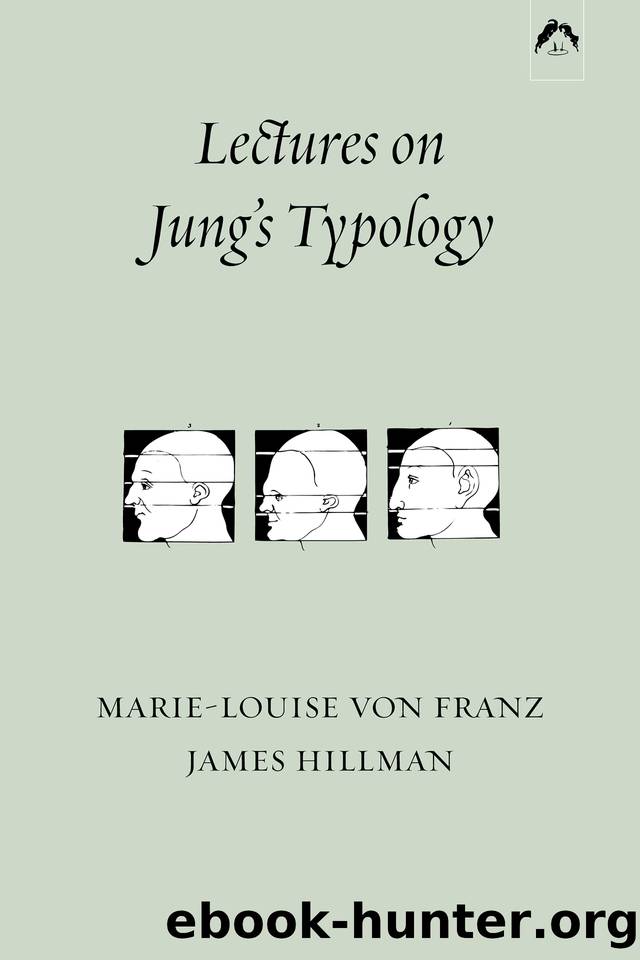Lectures on Jung's Typology by Hillman James & von Franz Marie-Louise

Author:Hillman, James & von Franz, Marie-Louise
Language: eng
Format: epub
Publisher: Spring Publications
Published: 2013-10-20T00:00:00+00:00
6
Jungian Descriptions and Distinctions
* * *
I would claim for Jung that he did much for resurrecting feeling and separating it from the collective prejudices. Neither Bleuler nor Freud, the two psychological masters with whom Jung was most closely associated, clearly separated feeling from emotion, from passion, from affectivity. In psychiatric and psychoanalytic literature today the feeling function is still buried in the general category of affectivity, whereas Jung differentiated feeling as a function of consciousness equal to thinking, sensing and intuiting already in 1921 in his Psychological Types.
By conceptually differentiating feeling and considering it a function of consciousness, Jung made a major contribution to the history or the concept of feeling. In evaluations of Jungâs typological work this achievement is often overlooked, and thereby an essential aspect of Jungian psychology is often neglected, leading to many unnecessary arguments. It is crucial to the understanding of Jungian psychology that feeling be brought to bear upon it. We cannot read Jung by intellect alone. Conscious comprehension in Jungian psychology means as well feeling comprehension. All the principal conceptual symbols (e.g., introversion, shadow, archetype, self, synchronicity) are as well experiences of feeling.
The complex may be defined most simply as a group of feeling-toned ideas; the symbol is recognized by its effect on feeling as well as by its sensuous impression, its intuitional meanings and its ideational content. Even that general goal of a Jungian analysisâthe cooperative relationship between ego consciousness and the unconscious dominantsâis, as a relationship, largely a function of feeling. Jungian therapy is not, as it is sometimes mistaken to be, mainly a matter of self-knowledge. Self-realization is a process of feeling realization, realizing what we feel, feeling what we are; and this process begins with the first therapeutic session, to which the person comes often owing to his disturbed feelings and which opens often with that question âHow do you feel?â
The assumption of feeling had its effect also on the later developments in Jungâs work, especially upon the anima concept and his explorations in many dimensions of the âfeminineâ pole of the psyche. The recognition of feeling can also be found in his rather free and open way of doing therapy unburdened by the rigidities of technique devised by intellect. His psychology therefore soon found ear among women and among artists, just as it soon met rejectionâwith notable exceptionsâin those places where feeling is undervalued: contemporary scientific medicine and psychology and the academies of learning.
Jung came upon the role of feeling experimentally; his earliest descriptions of feeling stem from his association experiments; where he found pure affective reasons (âyes,â âbadâ âlike,â etc.) to stimulus words, rather than associations in the stricter sense. Already in this early work during the first decade of the century, we can trace two aspects of the concept of feeling: on the one hand, feeling as a function that âlikes,â relates, makes judgments, connects, denies, evaluates; on the other hand, feelings as contents (hopes, longing, angers) that act in the association experiment as factors facilitating or disturbing associations.
Download
This site does not store any files on its server. We only index and link to content provided by other sites. Please contact the content providers to delete copyright contents if any and email us, we'll remove relevant links or contents immediately.
Bioenergetica by Alexander Lowen(1124)
Noise: A Flaw in Human Judgment by Sunstein Cass R. & Sibony Olivier & Kahneman Daniel(968)
The Data Detective by Tim Harford(946)
The Child in You by Stefanie Stahl(883)
Chatter by Ethan Kross(799)
The Science of Rapid Skill Acquisition by Peter Hollins(639)
Freedom by Sebastian Junger(633)
No Bad Parts by Richard C. Schwartz(608)
The Montessori Baby by Simone Davies(566)
Evolution Gone Wrong: The Curious Reasons Why Our Bodies Work by Alex Bezzerides(560)
The Quantum Psychiatrist: From Zero to Zen Using Evidence-Based Solutions Beyond Medication and Therapy by Biswas Dona(551)
Maps of Meaning: The Architecture of Belief by Jordan B. Peterson(551)
The Science of Self-Learning: How to Teach Yourself Anything, Learn More in Less Time, and Direct Your Own Education (Learning how to Learn Book 1) by Peter Hollins(522)
Anxiety For Dummies by Charles H. Elliott & Laura L. Smith(512)
Sadomasochism and the BDSM Community in the United States by Stephen K. Stein(498)
Disconnected by thomas Kersting(482)
Why Sex Doesn't Matter by Olivia Fane(481)
The Mechanics of Passions: Brain, Behaviour, and Society by Alain Ehrenberg(480)
Jung - The Key Ideas: Teach Yourself (TY Philosophy) by Ruth Snowden(468)
